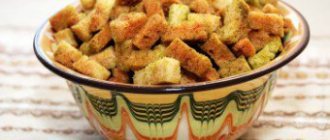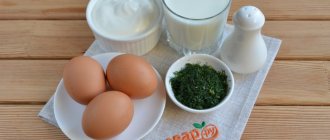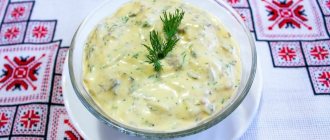Homemade mozzarella is a simple soft cheese that is often added to pizza, various salads and snacks. You can make mozzarella without pepsin and rennet! To do this, you only need two main ingredients: vinegar and homemade milk. The milk must be mature, unpasteurized, and high in fat. If the milk is boiled or store-bought, when vinegar is added, curd flakes will form, rather than delicate strings of cheese. The taste and smell of vinegar is absolutely not noticeable in the finished product! Homemade Mozzarella cheese has a delicate creamy aroma. The taste is balanced, creamy. The product turns out lightly salted.
Exit
Calorie content per 100 grams of food
Cooking time
Mozzarella: recipe
To make mozzarella you will need:
- 8-10 liters of whole milk (Never pasteurized! It will not make cheese).
- Rennet enzyme – 100 gr. (If you can't find it in stores, you can simply order it online).
- Half a lemon.
- Drinking water – 100 g. (You need to take the most purified water, without chlorine and impurities. It is better if it is bottled. You should not take tap water. It is too hard).
- 2 tablespoons salt.
- Basil or dill - as you wish.
Equipment you need is a gas stove or microwave. You'll also need a large saucepan, a cooking thermometer, and thick gloves. You can prepare your own mozzarella in just half an hour.
A few important secrets
Now let’s look at the important secrets of making cheese that must be followed:
- Avoid UHT milk. It won't make cheese. You shouldn't take pasteurized ones either. It is better to buy homemade milk with a fairly high fat content.
- By the way, when preparing mozzarella according to the classic recipe, it is not cow’s milk that is used, but buffalo milk. But this is not necessary for you. At home, it is quite possible to limit yourself to high-quality cow's milk with high fat content.
- Rennet is very important for making cheese. Thanks to it, the cheese curls and the desired texture is obtained. You can look for the enzyme in a pharmacy, at the market (in a spice shop), or simply order it on the Internet. The name may vary.
- You can replace lemon with regular citric acid (one-third of a teaspoon).
As you can see, making mozzarella cheese at home, despite its simplicity, is associated with some peculiarities of the technological process. Believe me, the homemade mozzarella, the recipe for which we will offer you, will not be much different in taste and consistency from the store-bought one. Of course, the original Italian cheese uses buffalo milk. But its advantage over cow's milk is only in its high casein content. This has little effect on the taste of the cheese.
Description and main types of mozzarella
Mozzarella can be distinguished from other cheeses by its appearance - these are medium-sized balls that float in brine. It is considered the most delicious one-day product, but to taste it, you will need to go to Italy.
There are several varieties of mozzarella - hard and smoked varieties.
Mozzarella cheese is layered in structure, has a delicate creamy taste, reminiscent of cottage cheese. Made according to a classic recipe from buffalo milk, it is saltier and fattier than those made from cow's milk.
Due to its soft structure, it is given different shapes, which is why it is called differently:
- Large balls are called bacconcini;
- Smaller balls - chiliegini;
- Small lumps the size of a pea - perlini;
- In the form of a braid - trechcha (it is also often smoked).
Preparation stages
If you are wondering how to make mozzarella cheese at home quickly and efficiently, then you must strictly follow the steps of preparation for this process. Be sure to pay attention to the preparation for the cooking process. You need to prepare as carefully as possible. The final result depends on this. You should not skip any steps and neglect the temperature regime. The quality of the cheese will depend on how accurate the temperature for cooking the cheese is. Therefore, be sure to buy a cooking thermometer.
Preparing the ingredients is as simple as possible:
- You need to squeeze the lemon and get the juice.
- You need to dilute the enzyme in water. Don't be afraid to add more than you need. An overdose of the enzyme is absolutely safe.
Features of storage and serving
Mozzarella cheese cannot be stored for long periods of time and is eaten immediately after preparation. But if you keep it in salty brine for a while, it will taste more piquant. It is permissible to keep it in this brine for no more than three days. If the cheese has acquired a sour or bitter taste, it means that it has spoiled and is no longer suitable for food. If this type of cheese is left without brine, the product will become dry and lose its delicate taste.
The brine is quite easy to prepare:
- Liter of whey;
- 4 tablespoons salt;
- Stir until the salt is completely dissolved.
Mozzarella cheese must be stored by placing it in brine and refrigerating it.
Served as a separate dish as an appetizer or as part of other dishes. Mozzarella cheese goes well with tomatoes and basil in the traditional Italian dish Caprese, and also goes well with white wine. Mozzarella is often consumed as a dessert with fruit and sweet wines.
In Italy, cheese is used in most recipes. Mozzarella will be good in making pasta, lasagna and pizza. This delicate product will add sophistication to your dishes.
How to make Philadelphia cheese at home, read a simple and tasty recipe.
Learn how to make Adyghe cheese at home and enjoy this healthy dish. Recipe here.
Read how to make low-fat cottage cheese at home. A recipe for those who watch their diet.
Cooking steps
So, you bought a thermometer, took out a saucepan, and prepared all the ingredients. Now you can safely start preparing this wonderful Italian cheese. We emphasize once again that each stage of preparation requires the most accurate adherence to technology.
Steps for making mozzarella:
- Heat unpasteurized cow's milk to 60-70 degrees. At the same time, stir it quite often.
- When the desired temperature is reached, pour in lemon juice, as well as the enzyme you diluted in advance. These ingredients will help the milk curdle quickly.
- Wait until the whey begins to separate. As soon as you notice. When it separates, immediately turn off the stove so that the milk does not boil. Now you need to wait about 15 minutes.
- Now look carefully at what you got. A homogeneous pancake of cheese should form. Its consistency should be quite viscous. Pay attention to the color of the serum. If you followed the cooking technology correctly, it should be a little cloudy, with a yellow tint.
- Now you need to drain the whey and squeeze the cheese thoroughly. Please note that this should be done while the cheese is quite hot. Therefore, you will need to use thick gloves. To lower the temperature slightly, periodically dip your hands in a container of cold water.
- You now have a dense lump of cheese. It should be warmed up. It is important that the heating is as uniform as possible. A microwave oven is ideal for this purpose. Feel free to turn on maximum power and leave the cheese in the oven for 1 minute. We indicated approximate times. It will depend on how powerful your microwave is and what your final product yield is. The larger the lump of cheese you get, the longer it will take to warm it up. Be sure to ensure that the cheese does not boil under any circumstances! It will be ruined if it boils!
- If you don't have a microwave, you can heat the cheese with water. You will need about one and a half liters of water. Heat it to 90 degrees. Now turn off the stove. Salt the water and put the whole cheese ball into it. Leave it in hot water for about 5 minutes.
- From now on you will work exclusively with gloves. Remove the lump of cheese from the water or microwave. You should have a pliable and soft mass in your hands.
- Now knead the cheese mass with special care. Don't be afraid to stretch and knead it. If you notice that the plasticity is decreasing, you need to heat the cheese ball again. The method is exactly the same as in step 6 or 7. You need to achieve homogeneity and a pleasant dense consistency of the cheese.
- While kneading the cheese, carefully form a layer of medium thickness. Fold it into an envelope shape. Then repeat the stretch again and knead thoroughly. Thanks to these simple manipulations, the cheese will have a characteristic fibrous texture.
- If you wish, you can add basil or dill. Thanks to these greens, the cheese will have a pleasant aroma.
- Next, you can shape your cheese into small balls. Or you can just leave a single lump. But it’s still preferable to use balls. They will look very interesting in salads and other dishes. In order to quickly form balls, you can take regular cling film. The cheese should still be hot when forming the balls. Cold cheese will become too dense and unplastic. You will no longer be able to form anything out of it. So, roll a sausage from a hot lump of cheese and wrap it in cling film. Then, using a thread, we separate the balls of the required size and tie them tightly enough.
- If you heated the cheese using a microwave oven, be sure to salt the whey.
- Now the mozzarella cheese is ready. Be sure to store it in salted whey, in a container that is tightly closed with a lid. The shelf life of the finished cheese is no more than a week. It must be stored in the refrigerator. Freezing is also allowed.
This is also interesting: How to make mascarpone at home
Mozzarella at home: recipe
The correct sequence of actions and adherence to temperature conditions will help you get the perfect product.
In addition to basic products, you need to prepare kitchen equipment. During the cooking process you will need:
- A deep bowl or saucepan for heating milk.
- Gauze, colander and slotted spoon to remove excess liquid.
- Food thermometer.
- A jar of water or other device that acts as a weight.
To extend the shelf life of homemade mozzarella , it is advisable to sterilize all utensils.
Balloons
List of ingredients:
- 25 rennet tablets
- 4 liters cow's milk
- 300 ml filtered water
- 20 g citric acid
- 1-2 tbsp. l. olive oil
- salt and spices to taste
Step-by-step technique for making homemade mozzarella:
- Pour 50 ml of drinking water into a deep bowl and add rennet.
- Separately, combine 250 ml of water and citric acid, stir until completely dissolved.
- Pour the milk product into a saucepan and heat over low heat. We control the heating temperature using a thermometer. For even heating, it is best to use a water bath.
- When the temperature reaches 30°C, add citric acid and stir constantly.
- When heated to 38 °C, the rennet component is added.
- Stir and bring to a temperature of 40°C.
- Remove the pan from the heat, cover with a lid and leave for 10-15 minutes alone. During this time, the curd mass should become thicker. The serum will have a yellowish tint.
- Using a slotted spoon, transfer the cottage cheese to a colander. In this case, it is more convenient to use a colander with large holes, not a mesh one. All excess moisture should drain off. Walk over the surface using light hand pressure.
- Divide the cottage cheese into small even portions.
- Place a bowl of water on the fire and, without bringing it to a boil, stop at a comfortable temperature for your hands. Add a little salt.
- Dip (do not throw) the cottage cheese into the water in small portions.
- As soon as the cottage cheese acquires a soft, voluminous structure, use a slotted spoon to squeeze out the required amount and begin kneading it with your hands.
- To form a smooth cheese texture, stretch and knead the cheese product several times. If the cheese mass does not stretch, but falls apart, then the cooking technology is broken.
- Gradually we arrive at a spherical shape. The warm-up process takes approximately 15 minutes.
- If the cheese becomes hard, it can be placed in hot water for a while.
Cooking at home
Cooking time takes more than an hour. From 4 liters of milk you get 300-400 g of quality cheese. Homemade mozzarella is ready to eat immediately after preparation. Just add some salt and pour some olive oil over it.
To store mozzarella balls, place them in a cold brine made from whey and salt. As the cheese sits in the brine, it will acquire an even saltier taste. The permissible shelf life is 2-3 days. Before serving the cheese, remove excess liquid from it.
Slices of homemade mozzarella can be alternated with tomato slices. Add basil and olive oil to create a caprese salad. The taste of mozzarella cheese is ideally complemented by sauces with lots of spices.
Making mozzarella at home will pleasantly surprise you with the end result. Homemade mozzarella is much tastier than store-bought mozzarella. Experiment and enjoy a quality product.
A little history
Italian cheese makers invented perhaps one of the most delicate cheeses - elite mozzarella. This cheese not only has excellent taste, it is also very healthy. According to scientists, if you regularly consume mozzarella, you can rejuvenate your body by about a year.
Where does this wonderful cheese come from? Its homeland is considered to be the Campania region of Italy. It is located on the hilly coast of the Tyrrhenian Sea and the beautiful picturesque islands in the Gulf of Naples. This region is home to cheerful and hardworking people. By the way, this is where one of the most formidable volcanoes in Europe is located - Vesuvius. But this formidable neighborhood does not frighten them at all. People here are used to believing in the best, working and enjoying simple and accessible things. The blessed sun shines here almost all year round. The sea gives residents freshness, and cows and goats graze on the majestic hills. They produce wonderful aromatic milk. It is in this small region that some of the most prestigious Mediterranean resorts are located: Capri, Procida and Ischia.
The spirit of Campania was fully absorbed by the majestic Naples. This ancient city has an amazing and colorful history. He saw more than one generation of the greatest political and cultural figures. It was here that many culinary masterpieces were born on a special scale.
It is in Campania that the world-famous Nocillo nut liqueur is produced, to which aromatic cinnamon and cloves are added. It was here that the glorious semi-sweet red wine Falerno, as well as the white wines Lacrimae Christi and Capri bianco, began to be produced. And what goes better with wine than delicate or well-aged sharp cheese? It was in Campania that the recipe for mozzarella, brilliant in its simplicity, was invented, as well as piquant provolone and caciocavallo. There is so much piquancy and restraint in these cheeses! They simply cannot imagine a single dish that does not contain at least a little cheese.
Mozzarella has become a worthless calling card of the Campania. While provolone and caciocavallo are made from cow's milk, the original mozzarella recipe uses full-fat buffalo milk. It contains a lot of casein, which gives mozzarella its characteristic density and viscousness. The name of the cheese is associated with the term mozzare. It means “to cut off”, “to tear off”. This term reflects one of the main operations in the production of mozzarella. It is very important to form it manually. It is believed that the best way to knead and shape this cheese is with your fingertips.
This product has quite an ancient history. The first mention of it dates back to the 6th century. If you believe the historical chronicles, then the main credit for the fact that the Italians recognized this delicate cheese belongs to the soldiers of Hannibal himself. Chronicle from the 12th century. says that the monks at the monastery of St. Lorenzo gave bread with provatura and mozza to numerous pilgrims. Modern historians believe that these names hide provolone and mozzarella cheeses.
The embodiment of tenderness itself
Do you want to taste the tenderness? Then try the mozzarella. It embodies all the tenderness and sophistication of Campania cuisine. The success of this cheese also lies in the fact that it is very simple and easy to prepare. Of course, the original cheese, made from the milk of buffaloes that grazed in the emerald meadows of Campania, is simply perfect. But in the preparation of this cheese, the use of cow's milk is also allowed. The cheesemakers of Campania carefully select fatty buffalo milk, filter it, pasteurize it, and ferment it. All ingredients are simmered in huge metal containers at a temperature of only 34–38 °C. They are heated using steam. After an hour, the milk begins to curdle. It is divided into small portions and allowed to settle. Then the whole mass is carefully divided into portions with special spatulas and sent to mature in salted whey. Then the cheese is carefully laid out on huge tables and dried for about half an hour. The master carefully monitors all stages. During drying, the so-called “aging” of the cheese occurs. It has a pronounced sourness. Italians especially like the sour taste of this cheese in winter.
It is very interesting to check the quality of the cheese. For this, the cheese maker takes 100 grams. heated cheese and pulls a thin thread out of it. If the cheese is of high quality, then the length of the thread should be at least 1 meter. All stages seem very simple, but they require considerable experience of the craftsmen. Their task is to produce a delicate, but at the same time sufficiently mature cheese. To do this, the cheese is heated to 90 °C and kneaded very thoroughly. The mass should be as elastic as possible. This delicate cheese is literally “spun”, constantly removing excess liquid. The cheese then takes on its final and very recognizable shape.
This is also interesting: Paolo Celli is an Italian culinary star
The secret of the unique taste of mozzarella is that at almost all stages of its birth it is prepared exclusively by hand. Thanks to this, it acquires special juiciness and softness. In Campania, literally every resident has been imbued with the philosophy of mozzarella from early childhood. Here this noble and popular product is created by entire families, with just their fingertips. Thanks to the special unique taste details, this cheese has entered the elite category. All over the world you can find these tiny, dense white balls that contain the sun and the scent of Campania. To keep the cheese longer, it is transported in a special salty solution in tightly closed containers. Italian cheese makers treat it very carefully, as if it were a fragile and expensive treasure.
Many people like the pleasant round shape of mozzarella, its elasticity and smoothness. Outwardly, it resembles noble and expensive porcelain. The cut of this delicious cheese reveals numerous layers, through which fragrant milk droplets ooze. Real mozzarella simply melts in your mouth, despite its apparent density and fibrousness. This delicacy is very healthy. It contains proteins, fats, calcium and phosphorus that are so important for our body. It has a lot of protein.
Features of Mozzarella
- Mozzarella cheese becomes soft in a short time at room temperature. Therefore, before using it, it is better to cool the cheese slightly to make it easier to grate if required by the recipe.
- Another distinctive feature is that the product is not afraid of low temperatures. That is, frozen homemade Mozzarella can be put in the refrigerator, and after slow defrosting it will fully retain all its properties.
- It melts perfectly, does not release fat, retains its characteristic viscosity and does not “dry out,” even after the dish has cooled.
- Mozzarella has a soft milky taste, without any harsh notes, which does not overpower the other main ingredients.
- It is consumed not only on its own, but also used in cooking. The main dish where it is used is pizza. Another popular dish is Italian lasagna or cheese fondue. Fresh Mozzarella is also included in salads, such as Caprese. It is also included in pasta, French fries, stuffed champignons and much more.
Types of mozzarella
This cheese amazes with its diversity. He is very diverse. All its types are successfully used in numerous Italian dishes. First of all, these are salads and the famous Italian pizza. The peculiarity of the original Italian mozzarella is that it is given the DOP (Denominazione di Origine Protetta) brand. The original product from Italy can be recognized by the label with the image of a buffalo head, as well as the yellow and blue logo. This cheese is very highly valued, but its price is considerable. Moreover, in order for him to receive the coveted brand, he must meet the most stringent requirements. To assign it, the following is taken into account:
- place of its production;
- climate;
- the degree of its salting;
- the quality of the salt itself;
- cheese production traditions.
The human factor is also important in its brewing. The master cheese maker must strictly follow all the requirements of the technology for its brewing. If he starts experimenting or neglecting the traditional recipe, then, of course, he will end up with cheese. But it won't be mozzarella anymore.
Classic Italian mozzarella, as we have already mentioned, is brewed from black buffalo milk. These are animals of a special unique breed. In the fragrant pastures of sunny Campania, they are grown using a special ancient technology.
Mozzarella di latte di bufala - this cheese is also made from buffalo milk. But they are no longer grown in Southern Italy. This mark is also given to those cheeses that for some reason did not receive the coveted DOP mark.
Mozzarella con latte di bufala is a rare labeling of mozzarella. It means that this cheese is made from buffalo milk, but cow's milk was also added to it.
Mozzarella tradizionale - this brand produces mozzarella, which is made from cow's milk. It is very popular in Europe and Russia. This cheese is less demanding in terms of storage conditions. Also, its production does not place such high demands on the quality of the starting ingredients as in previous brands of cheese. It was this brand that was most often found in Russia and European countries. Most often, the label “Mozzarella curd cheese” was placed next to it. This is a product with delicate curd notes. It is highly regarded as a traditional cheese from Italy, which is brewed according to a long-standing traditional recipe. It is this type of mozzarella that is most often sold in the form of characteristic rolls or balls that are soaked in brine or whey. This category also includes the cheese that is often used for pizza. It can also be used as an independent dish. This type of cheese has slightly lower fat content than others. It is about 40%.
Mozzarella o for di latte - literally this name is translated as “milk flower”. This is mozzarella, which is made from cow's milk with less fat. The term magra can be found on its label. It means that the fat content of this product is no more than 20%. But if you find the inscription leggera on the label, it means the fat content is 20-35%. For Russia, the English word “light” or “light” is often used. This cheese is very popular among those who prefer to control their weight and strive not to consume too high-calorie and fatty varieties of cheese.
Homemade mozzarella: features, cooking tips
Mozzarella has a salty, creamy flavor. What distinguishes it from other cheeses is its original shape. According to the cooking technology, this type of cheese is rolled into balls, which are stored in brine or whey.
IMPORTANT: To make mozzarella you only need fresh milk.
The shelf life of this product is very short, so the cheese is purchased or prepared immediately before use.
Depending on its size, mozzarella is divided into several minor names. The fine granular form resembles pearls in its whiteness and is called “Perlini”. The cherry-sized cheese balls are called Ciliegini. Large pieces, the size of a tennis ball or larger, are called “Bocconcini”.
Smoked mozzarella, unlike classic mozzarella, has a longer shelf life. This variety is most often sold in the form of braids and is an excellent independent snack.
Cook at home
Before you start making homemade mozzarella , familiarize yourself with the main features of this product.
- Storing cheese at room temperature affects its density. It is more convenient and easier to cut mozzarella from the refrigerator.
- Low temperature does not impair the beneficial properties of this product.
- Homemade mozzarella melts perfectly under high temperatures and, unlike ordinary types of cheese, does not tan when cooling.
- The neutral taste of mozzarella ideally complements many different dishes and does not interrupt the taste of other products.
- The taste of homemade mozzarella directly depends on the quality of the water used, the freshness and fat content of the dairy product. In extreme cases, whole milk can be replaced with dry milk. The use of chlorinated water during the cooking process is absolutely inappropriate.
- The low calorie content of mozzarella makes it an ideal dietary product. Eating mozzarella by children and pregnant women provides the necessary amount of calcium and other useful substances.











